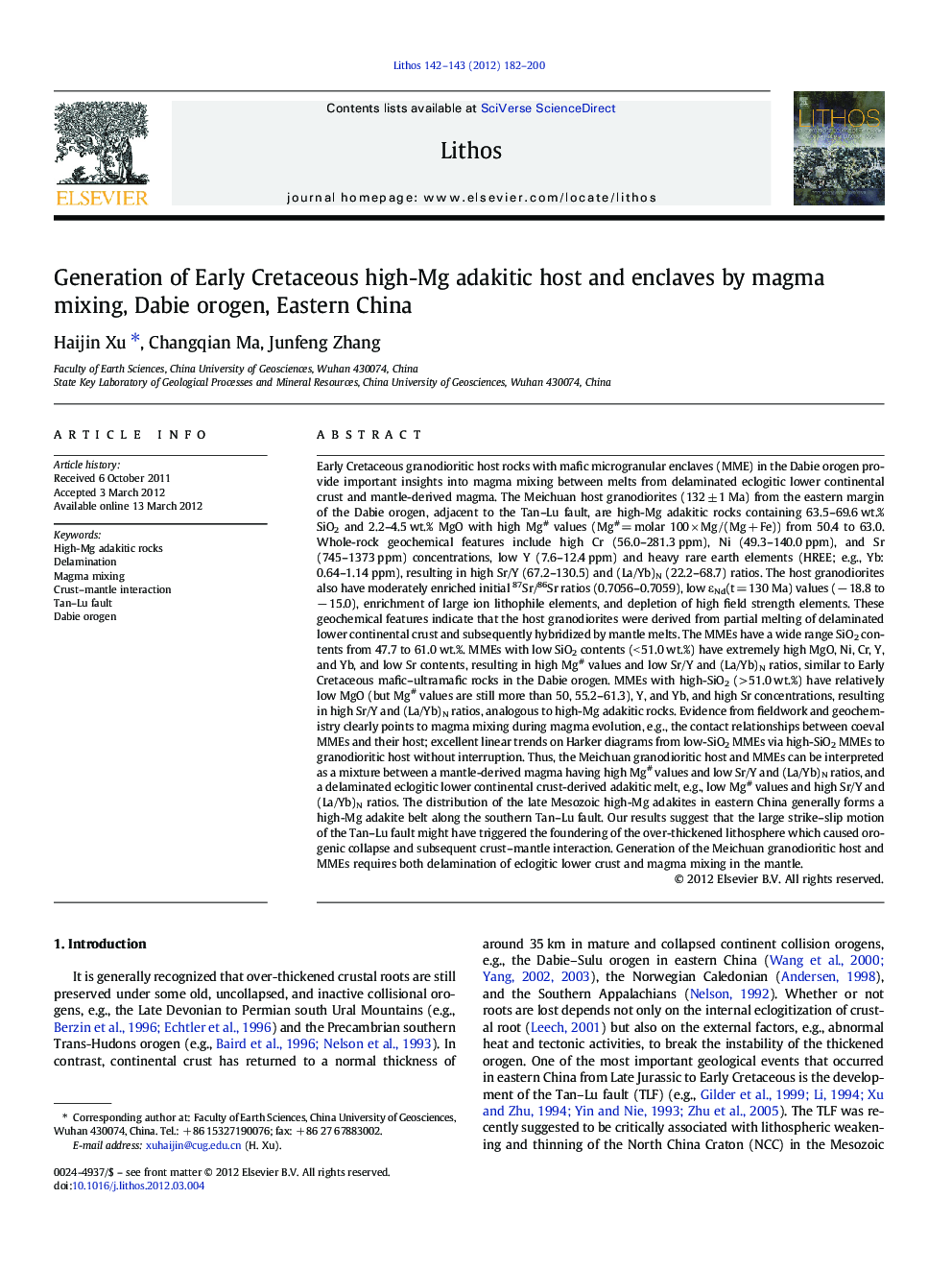| کد مقاله | کد نشریه | سال انتشار | مقاله انگلیسی | نسخه تمام متن |
|---|---|---|---|---|
| 4716601 | 1638708 | 2012 | 19 صفحه PDF | دانلود رایگان |

Early Cretaceous granodioritic host rocks with mafic microgranular enclaves (MME) in the Dabie orogen provide important insights into magma mixing between melts from delaminated eclogitic lower continental crust and mantle-derived magma. The Meichuan host granodiorites (132 ± 1 Ma) from the eastern margin of the Dabie orogen, adjacent to the Tan–Lu fault, are high-Mg adakitic rocks containing 63.5–69.6 wt.% SiO2 and 2.2–4.5 wt.% MgO with high Mg# values (Mg# = molar 100 × Mg / (Mg + Fe)) from 50.4 to 63.0. Whole-rock geochemical features include high Cr (56.0–281.3 ppm), Ni (49.3–140.0 ppm), and Sr (745–1373 ppm) concentrations, low Y (7.6–12.4 ppm) and heavy rare earth elements (HREE; e.g., Yb: 0.64–1.14 ppm), resulting in high Sr/Y (67.2–130.5) and (La/Yb)N (22.2–68.7) ratios. The host granodiorites also have moderately enriched initial 87Sr/86Sr ratios (0.7056–0.7059), low εNd(t = 130 Ma) values (− 18.8 to − 15.0), enrichment of large ion lithophile elements, and depletion of high field strength elements. These geochemical features indicate that the host granodiorites were derived from partial melting of delaminated lower continental crust and subsequently hybridized by mantle melts. The MMEs have a wide range SiO2 contents from 47.7 to 61.0 wt.%. MMEs with low SiO2 contents (< 51.0 wt.%) have extremely high MgO, Ni, Cr, Y, and Yb, and low Sr contents, resulting in high Mg# values and low Sr/Y and (La/Yb)N ratios, similar to Early Cretaceous mafic–ultramafic rocks in the Dabie orogen. MMEs with high-SiO2 (> 51.0 wt.%) have relatively low MgO (but Mg# values are still more than 50, 55.2–61.3), Y, and Yb, and high Sr concentrations, resulting in high Sr/Y and (La/Yb)N ratios, analogous to high-Mg adakitic rocks. Evidence from fieldwork and geochemistry clearly points to magma mixing during magma evolution, e.g., the contact relationships between coeval MMEs and their host; excellent linear trends on Harker diagrams from low-SiO2 MMEs via high-SiO2 MMEs to granodioritic host without interruption. Thus, the Meichuan granodioritic host and MMEs can be interpreted as a mixture between a mantle-derived magma having high Mg# values and low Sr/Y and (La/Yb)N ratios, and a delaminated eclogitic lower continental crust-derived adakitic melt, e.g., low Mg# values and high Sr/Y and (La/Yb)N ratios. The distribution of the late Mesozoic high-Mg adakites in eastern China generally forms a high-Mg adakite belt along the southern Tan–Lu fault. Our results suggest that the large strike–slip motion of the Tan–Lu fault might have triggered the foundering of the over-thickened lithosphere which caused orogenic collapse and subsequent crust–mantle interaction. Generation of the Meichuan granodioritic host and MMEs requires both delamination of eclogitic lower crust and magma mixing in the mantle.
Figure optionsDownload as PowerPoint slideHighlights
► We investigated the high-Mg adakitic host and enclaves in the Dabie orogen.
► Generation of them is related to crustal foundering and subsequent magma mixing.
► Magma mixing occurred between mantle-derived magma and melt from delaminated crust.
► The large strike–slip motion of Tan–Lu fault might have triggered the orogenic collapse.
Journal: Lithos - Volumes 142–143, June 2012, Pages 182–200